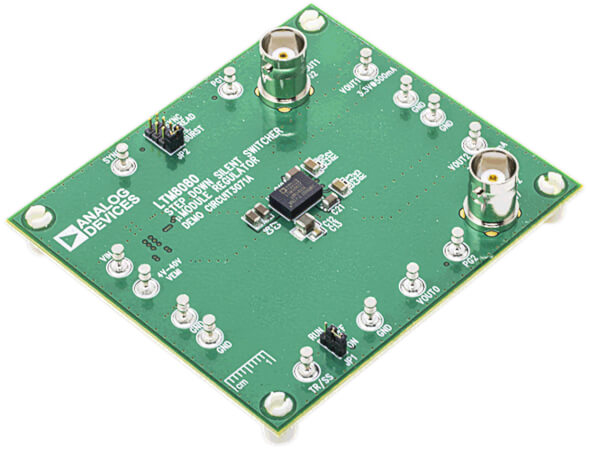Analog Devices Releases Regulators for Noise-sensitive Applications
Semiconductor giant Analog Devices recently released an ultra-low noise dual output μModule regulator for high-speed data converters, RF devices, transceivers, sensors, medical imaging, and other applications.
Massachusetts-based Analog Devices recently announced it’s updating its μModule (micromodule) portfolio with a new ultra-low noise dual output DC/DC regulator, dubbed “LTM8080,” for noise-sensitive applications requiring high power supply rejection ratios (PSRR). The product was announced during last week’s Applied Power Electronics Conference (APEC) in Orlando.

A demonstration circuit for Analog Devices’ new LTM8080 μModule regulator. Image used courtesy of Analog Devices
Designed to power digital loads susceptible to switching regulator noise, LTM8080 serves several applications, such as data converters, radio frequency transmitters, field programmable gate array input/output and clock designs, operational amplifiers, transceivers, and medical scanners. The new regulator product has an input voltage of up to 40 volts (V) and an output of 0 V to 8 V.
Video used courtesy of Analog Devices
LTM8080 Silent Switcher Technology
According to ADI, the LTM8080 regulator integrates a “Silent Switcher” architecture to reduce electromagnetic interference (EMI) emissions. The high-efficiency front end is accompanied by two low-noise, low-dropout regulators. Featuring packaging with a metallic EMI shield (as shown in the image below), the product can reduce output ripple voltage by up to 70% compared to discrete devices without a barrier.

A closer look at LTM8080’s application circuit. Image used courtesy of Analog Devices
It also features adjustable switching frequencies ranging from 200 kilohertz (kHz) to 2 megahertz (MHz) and operation mode selections to prevent frequency interference for ultra-low-noise instrumentation and high-speed signal chain applications.
Overall, LTM8080 can achieve low noise values of <1 µVRMS (10 Hz to 100 kHz), 2 nV/√Hz spot noise, and 80 dB PSRR (100 kHz).
Now at full production, the LTM8080 comes in two price points of $12.83 and $14.11 each per 1,000 units.
ADI’s Regulator Product Family
The new LTM8080 regulator is part of ADI’s μModule-branded micromodule regulator family, comprising system-in-package products incorporating high-performance analog integrated circuits (ICs), power switches, and passive components for applications like autonomous vehicles, artificial intelligence, battery-based systems, and test and measurement technologies.

Analog Devices’ new LTM8080 product. Image used courtesy of Analog Devices
The portfolio includes several power products, such as battery chargers, boost and buck-boost regulators, buck and inverting regulators, LED drivers, and regulators equipped with digital power system management functions.
For some broader context: As of the fourth quarter of 2022, ADI claimed a 10.81% market share over its competitors, per data from CSIMarket.
Part of that dominance traces back to its $20.8 billion acquisition of competitor Maxim Integrated in 2021, which enabled the company to grow its analog and mixed-signal portfolio and expand its reach in more markets, such as industrial, automotive, and data center customers.
According to its latest annual report, ADI has 125,000 customers spread globally, of which 62% are distributors and over one-third are direct customers like original equipment manufacturers and United States government entities.
The publicly traded company delivered record revenues of $12 billion last year (up 64% from 2021), hitting all-time highs across its business-to-business industrial, automotive, and communications segments.
With $2.7 billion in net income, ADI Chief Executive Officer Vincent Roche stated in the earnings release that 2022 was the most profitable year in the firm’s 58-year history. It closed the year with a strong backlog and stabilizing orders, despite economic headwinds causing demand uncertainty.






